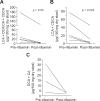Modulation of the fecal bile acid profile by gut microbiota in cirrhosis
- PMID: 23333527
- PMCID: PMC3936319
- DOI: 10.1016/j.jhep.2013.01.003
Modulation of the fecal bile acid profile by gut microbiota in cirrhosis
Abstract
Background & aims: The 7α-dehydroxylation of primary bile acids (BAs), chenodeoxycholic (CDCA) and cholic acid (CA) into the secondary BAs, lithocholic (LCA) and deoxycholic acid (DCA), is a key function of the gut microbiota. We aimed at studying the linkage between fecal BAs and gut microbiota in cirrhosis since this could help understand cirrhosis progression.
Methods: Fecal microbiota were analyzed by culture-independent multitagged-pyrosequencing, fecal BAs using HPLC and serum BAs using LC-MS in controls, early (Child A) and advanced cirrhotics (Child B/C). A subgroup of early cirrhotics underwent BA and microbiota analysis before/after eight weeks of rifaximin.
Results: Cross-sectional: 47 cirrhotics (24 advanced) and 14 controls were included. In feces, advanced cirrhotics had the lowest total, secondary, secondary/primary BA ratios, and the highest primary BAs compared to early cirrhotics and controls. Secondary fecal BAs were detectable in all controls but in a significantly lower proportion of cirrhotics (p<0.002). Serum primary BAs were higher in advanced cirrhotics compared to the rest. Cirrhotics, compared to controls, had a higher Enterobacteriaceae (potentially pathogenic) but lower Lachonospiraceae, Ruminococcaceae and Blautia (7α-dehydroxylating bacteria) abundance. CDCA was positively correlated with Enterobacteriaceae (r=0.57, p<0.008) while Ruminococcaceae were positively correlated with DCA (r=0.4, p<0.05). A positive correlation between Ruminococcaceae and DCA/CA (r=0.82, p<0.012) and Blautia with LCA/CDCA (r=0.61, p<0.03) was also seen. Prospective study: post-rifaximin, six early cirrhotics had reduction in Veillonellaceae and in secondary/primary BA ratios.
Conclusions: Cirrhosis, especially advanced disease, is associated with a decreased conversion of primary to secondary fecal BAs, which is linked to abundance of key gut microbiome taxa.
Copyright © 2013 European Association for the Study of the Liver. Published by Elsevier B.V. All rights reserved.
Conflict of interest statement
Figures

Comment in
-
Cirrhosis, bile acids and gut microbiota: unraveling a complex relationship.Gut Microbes. 2013 Sep-Oct;4(5):382-7. doi: 10.4161/gmic.25723. Epub 2013 Jul 12. Gut Microbes. 2013. PMID: 23851335 Free PMC article.
References
-
- Chen Y, Yang F, Lu H, Wang B, Lei D, Wang Y, et al. Characterization of fecal microbial communities in patients with liver cirrhosis. Hepatology. 2011;54:562–572. - PubMed
-
- Islam KB, Fukiya S, Hagio M, Fujii N, Ishizuka S, Ooka T, et al. Bile acid is a host factor that regulates the composition of the cecal microbiota in rats. Gastroenterology. 2011;141:1773–1781. - PubMed
-
- Ridlon JM, Kang DJ, Hylemon PB. Bile salt biotransformations by human intestinal bacteria. J Lipid Res. 2006;47:241–259. - PubMed
Publication types
MeSH terms
Substances
Grants and funding
LinkOut - more resources
Full Text Sources
Other Literature Sources
Medical
Research Materials

